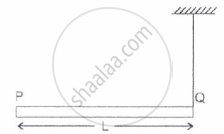Advertisements
Advertisements
प्रश्न
A particle starts from the origin at t = 0 s with a velocity of 10.0 `hatj "m/s"` and moves in the x-y plane with a constant acceleration of `(8.0 hati + 2.0 hatj) ms^(-2)`.
- At what time is the x-coordinate of the particle 16 m? What is the y-coordinate of the particle at that time?
- What is the speed of the particle at the time?
उत्तर १
Velocity of the particle `vecv = 10.0 hatj` m/s
Acceleration of the particle = `veca = (8.0 hati + 2.0 hatj)`
Also
But `veca = (dvecv)/(dt) = 8.0 hati +2.0 hatj`
`(dvecv) = (8.0 hati + 2.0 hatj)dt`
Integrating both sides:
`vecv(t)= 8.0t hati + 2.0t hatj + vecu`
where
`vecu` = velocity vector of the particle at t= 0
`vecv` = velocity vector of the particle at time t
But `vecv = (dvecr)/(dt)`
`dvecr = vecvdt = (8.0t hati + 2.0t hatj + vecu)dt`
Integrating the equations with the conditions: at t = 0; r = 0 andat t = t; r = r
`vecr = vecut + 1/28.0t^2 hati + 1/2xx2.0t^2 hatj`
`=vecut + 4.0t^2 hati + t^2 hatj`
`=(10.0 hatj)t + 4.0t^2 hati + t^2 hatj`
`x hati + y hatj = 4.0t^2 hati + (10t + t^2)hatj`
Since the motion of the particle is confined to the x-y plane, on equating the coefficients of `hati "and" hatj`, we get:
`x = 4t^2`
`t = (x/4)^(1/2)`
And `y = 10t + t^2`
(a) When x = 16 m
`t=(16/4)^(1/2)= 2s`
∴ y = 10 × 2 + (2)2 = 24 m
(b) Velocity of the particle is given by:
`vecv(t) = 8.0t hati + 2.0t hatj + hatu`
at t = 2s
`vecv(t) = 8.0 xx 2 hati + 2.0 xx 2 hatj + 10 hatj`
=`16 hati+ 14 hatj`
∴Speed of the particle
`|vecv| = sqrt((16)^2 + (14)^2)`
`=sqrt(256+196) = sqrt(452)`
`= 21.26 "m/s"`
उत्तर २
it is given that `vecr_(t = 0s) = vecv_(0) = 10.0 hatj` m/s and `veca(t) = (8.0 hati + 2.0 hatj) ms^(-2)`
(a) it means `x_0 = 0,u_x = 0, a_x = 8.0` `ms^(-2)` and x = 16 m
Using relation `s = x - x_0 = u_xt+1/2a_xt^2` we have
`16 - 0 = 0 + 1/2 xx 8.0 xx t^2 => t = 2s`
`:.y = y_0 + u_yt+ 1/2a_yt^2 = 0 + 10.0xx2+1/2xx2.0xx(2)^2`
= 20 + 4 = 24 m
(b) Velocity of particle at t= 2 s along x-axis
`v_x = u_x+a_xt=0 + 8.0 xx 2 = 16.0` m/s
and along y-axis `v_y = u_y+a_yt = 10.0 + 2.0 xx 2 = 14.0` m/s
∴Speed of particle at t = 2s
`v= sqrt(v_x^2+v_y^2) = sqrt((16.0)^2+(14.0)^2) = 21.26 ms^(-1)`
APPEARS IN
संबंधित प्रश्न
For a particle performing uniform circular motion `vecv=vecomegaxxvecr`obtain an expression for linear acceleration of the particle performing non-uniform circular motion.
Is it possible to have an accelerated motion with a constant speed? Name such type of motion.
Solve the following problem.
A particle moves in a circle with a constant speed of 15 m/s. The radius of the circle is 2 m. Determine the centripetal acceleration of the particle.
Solve the following problem.
A projectile is thrown at an angle of 30° to the horizontal. What should be the range of initial velocity (u) so that its range will be between 40m and 50 m? Assume g = 10 m s-2.
A particle of mass m is executing uniform circular motion on a path of radius r. If p is the magnitude of its linear momentum, the radial force acting on the particle is ______.
Select the WRONG statement.
The motion of the bus is ______ motion.
A rod PQ of mass M and length L is hinged at end P. The rod is kept horizontal by a massless string tied to point Q as shown in figure. When string is cut, the initial angular acceleration of the rod is ______.

A thin uniform circular disc of mass M and radius R is rotating in a horizontal plane about an axis passing through its centre and perpendicular to its plane with an angular velocity ω. Another disc of same dimensions, but of mass `1/4`M is placed gently on the first disc co-axially. The. angular velocity of the system is ______.
The kinetic energy K of a particle moving along a circle of radius R depends on the distance covered s as K = as2, where a is a constant. The force acting on the particle is ______.
